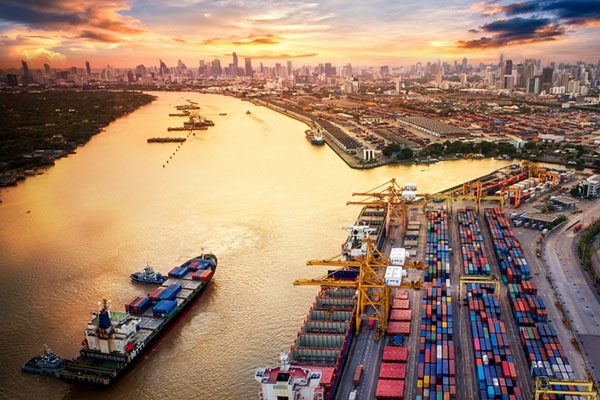Port Tracker points to volume gains, and a record 2018, while potential tariff hikes await

As was the case in its previous edition, the Port Tracker report issued today by the National Retail Federation (NRF) and maritime consultancy Hackett Associates, a decrease in the number of imports coming into United States-based retail container ports are down, when compared to the peak volumes that were intact last fall. But volumes are still above average, due to a potential increase in tariffs applied to goods from China, which could take effect in March.
The ports surveyed in the report include: Los Angeles/Long Beach, Oakland, Tacoma, Seattle, Houston, New York/New Jersey, Hampton Roads, Charleston, and Savannah, Miami, Jacksonville, and Fort Lauderdale, Fla.-based Port Everglades.
Authors of the report explained that cargo import numbers do not correlate directly with retail sales or employment because they count only the number of cargo containers brought into the country, not the value of the merchandise inside them, adding that the amount of merchandise imported provides a rough barometer of retailers’ expectations.
“With trade talks with China still unresolved, retailers appear to be bringing spring merchandise into the country early in case tariffs go up in March,” NRF Vice President for Supply Chain and Customs Policy Jonathan Gold said. “We are hopeful that the talks will succeed, but until the trade war is behind us, retailers need to do what they can to mitigate the higher prices that will inevitably come with tariffs.”
The report noted that the 10% U.S. tariffs on $200 billion worth of China-originated goods, which went into effect in September 2018, are set to go up to 25% on March 1, pending the outcome of U.S.-China negotiations that have been ongoing since late last year.
Port Tracker reported that U.S.-based retail container ports handled 1.97 million TEU (Twenty-Foot Equivalent Units), in December, the most recent month for which data is available. This represents an 8.8% increase compared to November and a 13.9% annual gain. Total 2018 volume, at 21.8 million TEU, topped 2017’s 20.5 million TEU by 6.2%, setting a new record in the process.
The report said January was estimated at 1.83 million TEU, which would mark a 4.1% annual increase, with February pegged at 1.78 million TEU for a 5.7% increase. March and April, at 1.89 million TEU and 1.76 million TEU, are expected to be up 3.8% and 7.7%, respectively. And May’s expected 1.89 million TEU (a 3.4% annual gain) and June’s 1.86 million TEU (a 0.3% annual gain) would see a first half total of 10.7 million TEU for a 4.1% annual gain, the report said.
“Containerized imports to North America continue to be robust, with retailers and other businesses trying to beat potential tariff increases in March since they can see that trade talks are not progressing smoothly,” wrote Hackett Associates Founder Ben Hackett wrote in the report. “The problem here is that warehouses and storage facilities are running out of space. Imports in 2018 ended with a 6.2 percent increase over 2017 with the East Coast up 7.9 percent vs. the West Coast at only 4.7 percent. Some of that can be attributed to the pattern of ship operations and warehousing. Our projection for 2019 remains in positive territory but with year-on-year growth only a third of last year. Exports, on the other hand, have been hit by the trade disputes, particularly in the agricultural sector. The question is how long can the US economy out-perform the global economy as further economic downturns are anticipated in Europe and Asia?”

Article Topics
3PL News & Resources
UPS rolls out fuel surcharge increases Descartes announces acquisition of Dublin, Ireland-based Aerospace Software Developments Shipment and expenditure decreases trend down, notes Cass Freight Index March trucking tonnage trends down, reports ATA FTR Shippers Conditions Index enters negative territory DAT March Truckload Volume Index sees modest March gains National diesel average, for week of April 22, is down for the second straight week More 3PLLatest in Logistics
Understanding the FTC’s ban on noncompetes UPS rolls out fuel surcharge increases U.S. rail carload and intermodal volumes, for week of April 20, are mixed, reports AAR Baltimore suing ship that crashed into bridge, closing port, costing jobs Intermodal growth volume remains intact in March, reports IANA Descartes announces acquisition of Dublin, Ireland-based Aerospace Software Developments Amid ongoing unexpected events, supply chains continue to readjust and adapt More LogisticsAbout the Author
Subscribe to Logistics Management Magazine

Find out what the world's most innovative companies are doing to improve productivity in their plants and distribution centers.
Start your FREE subscription today.
April 2023 Logistics Management

Latest Resources














